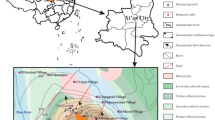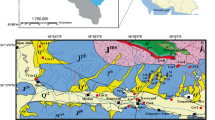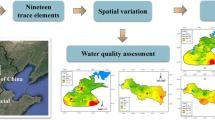Abstract
Contamination from organic chemical plants can cause serious pollution of soil and groundwater ecosystems. To characterize soil contamination and to evaluate the health risk posed by groundwater at a typical organic chemical plant site in Chongqing, China, 91 soil samples and seven groundwater samples were collected. The concentrations of different contaminants and their three-dimensional distribution were determined based on the 3D-krige method. Groundwater chemistry risk index (Chem RI) and cancer risk were calculated based on TRIAD and RBCA models. The chemistry risk indices of groundwater points SW5, SW18, SW22, SW39, SW52, SW80, and SW82 were 0.4209, 0.9972, 0.9324, 0.9990, 0.9991, 1.0000, and 1.0000, respectively, indicating that the groundwater has poor environmental status. By contrast, the reference Yangtse River water sample showed no pollution with a Chem RI of 0.1301. Benzene and 1,2-dichloroethane were the main contaminants in the groundwater and were responsible for the elevated cancer risk. The cumulative health risk of groundwater points (except SW5 and SW18) were all higher than the acceptable baselines of 10−6, which indicates that the groundwater poses high cancer risk. Action is urgently required to control and remediate the risk for human health and groundwater ecosystems.





Similar content being viewed by others
References
American Society for Testing, Materials (ASTM). (2010). Standard guide for risk-based corrective action E2081-00(2010); [West Conshohocken, PA, USA].
Aydin, F. A., & Soylak, M. (2010). Separation, preconcentration and inductively coupled plasma-mass spectrometric (ICP-MS) determination of thorium(IV), titanium(IV), iron(III), lead(II) and chromium(III) on 2-nitroso-1-naphthol impregnated MCI GEL CHP20P resin. Journal of Hazardous Materials, 173, 669–674.
Baderna, D., Colombo, A., Amodei, G., Cantù, S., Teoldi, F., Cambria, F., et al. (2013). Chemical-based risk assessment and in vitro models of human health effects induced by organic pollutants in soils from the Olona valley. Science of the Total Environment, 463, 790–801.
Bargaoui, Z. K., & Chebbi, A. (2009). Comparison of two kriging interpolation methods applied to spatiotemporal rainfall. Journal of Hydrology, 365(1), 56–73.
Beijing Bureau of Quality and Technical Supervision. (2011). Screening Levels for Soil Environmental Risk Assessment of Sites, DB11/T 811-2011.
Brasseur, C., Brose, F., Pirlot, A., Douny, C., Eppe, G., Maghuin-Rogister, G., & Scippo, M. L. (2007). Validation of the analytical procedure for the determination of polyaromatic hydrocarbons in smoke flavourings using high performance liquid chromatography coupled to an ultraviolet, diode array or fluorescence detector. Accreditation and Quality Assurance, 12(10), 535–542.
Cattle, J. A., McBratney, A., & Minasny, B. (2002). Kriging method evaluation for assessing the spatial distribution of urban soil lead contamination. Journal of Environmental Quality, 31(5), 1576–1588.
Chapman, P. M., Paine, M. D., Arthur, A. D., & Taylor, L. A. (1996). A triad study of sediment quality associated with a major, relatively untreated marine sewage discharge. Marine Pollution Bulletin, 32(1), 47–64.
Chen, Y., & Ma, H. (2006). Model comparison for risk assessment: A case study of contaminated groundwater[J]. Chemosphere, 63(5), 751–761.
Chen, F., Ying, G. G., Kong, L. X., Wang, L., Zhao, J. L., Zhou, L. J., & Zhang, L. J. (2011). Distribution and accumulation of endocrine-disrupting chemicals and pharmaceuticals in wastewater irrigated soils in Hebei, China. Environmental Pollution, 159(6), 1490–1498.
Crévecoeur, S., Debacker, V., Joaquim-Justo, C., Gobert, S., Scippo, M. L., Dejonghe, W., et al. (2011). Groundwater quality assessment of one former industrial site in Belgium using a TRIAD-like approach. Environmental Pollution, 159(10), 2461–2466.
Critto, A., Carlon, C., & Marcomini, A. (2003). Characterization of contaminated soil and groundwater surrounding an illegal landfill (S. Giuliano, Venice, Italy) by principal component analysis and kriging. Environmental Pollution, 122, 235–244.
Di Sante, M., Mazzieri, F., & Pasqualini, E. (2009). Assessment of the sanitary and environmental risks posed by a contaminated industrial site. Journal of Hazardous Materials, 171(1), 524–534.
Ding, J., & Hua, W. (2012). Featured chemical industrial parks in China: History, current status and outlook. Resources, Conservation and Recycling, 63, 43–53.
Fan, C., Chen, Y. C., Ma, H. W., & Wang, G. S. (2010). Comparative study of multimedia models applied to the risk assessment of soil and groundwater contamination sites in Taiwan. Journal of Hazardous Materials, 182(1), 778–786.
Geng, C., Gao, Y., Li, D., Jian, X., & Hu, Q. (2014). Contamination investigation and risk assessment of molybdenum on an industrial site in China. Journal of Geochemical Exploration, 144, 273–281.
Goovaerts, P. (1997). Geostatistics for natural resources evaluation (p. 483). New York, NY: Oxford University Press.
Goovaerts, P., Trinh, H. T., Demond, A., Franzblau, A., Garabrant, D., Gillespie, B., et al. (2008). Geostatistical modeling of the spatial distribution of soil dioxins in the vicinity of an incinerator. 1. Theory and application to Midland, Michigan. Environmental Science and Technology, 42(10), 3648–3654.
Hamonts, K., Kuhn, T., Maesen, M., Bronders, J., Lookman, R., Kalka, H., et al. (2009). Factors determining the attenuation of chlorinated aliphatic hydrocarbons in eutrophic river sediment impacted by discharging polluted groundwater. Environmental Science and Technology, 43(14), 5270–5275.
He, G., Zhang, L., Lu, Y., & Mol, A. P. (2011). Managing major chemical accidents in China: Towards effective risk information. Journal of Hazardous Materials, 187(1), 171–181.
Hollert, H., Heise, S., Pudenz, S., Brüggemann, R., Ahlf, W., & Braunbeck, T. (2002). Application of a sediment quality triad and different statistical approaches (Hasse diagrams and fuzzy logic) for the comparative evaluation of small streams. Ecotoxicology, 11(5), 311–321.
Jensen, J., & Mesman, M. (2006). Ecological risk assessment of contaminated land: decision support for site specific investigations. Bilthoven: RIVM. ISBN 90-6960-138-9.
Jing, C., Meng, X., Calvache, E., & Jiang, G. (2009). Remediation of organic and inorganic arsenic contaminated groundwater using a nanocrystalline TiO 2-based adsorbent. Environmental Pollution, 157(8), 2514–2519.
Li, L., & Revesz, P. (2004). Interpolation methods for spatio-temporal geographic data. Computers, Environment and Urban Systems, 28(3), 201–227.
Liu, G., Bi, R., Wang, S., Li, F., & Guo, G. (2013). The use of spatial autocorrelation analysis to identify PAHs pollution hotspots at an industrially contaminated site. Environmental Monitoring and Assessment, 185(11), 9549–9558.
Long, E. R., & Chapman, P. M. (1985). A sediment quality triad: measures of sediment contamination, toxicity and infaunal community composition in Puget Sound. Marine Pollution Bulletin, 16(10), 405–415.
Ma, X., Tan, Z., Pang, L., & Liu, J. (2013). Determination of VOCs in groundwater at an industrial contamination site using a homemade low-density polyethylene passive diffusion sampler. Journal of Environmental Sciences, 25(11), 2338–2343.
Mattsson, Å., Lundstedt, S., & Stenius, U. (2009). Exposure of HepG2 cells to low levels of PAH-containing extracts from contaminated soils results in unpredictable genotoxic stress responses. Environmental and Molecular Mutagenesis, 50(4), 337–348.
Ministry of Environmental Protection of the People’s Republic of China. (2007). Standard of soil quality assessment for exhibition sites, HJ 350-2007.
Office of Solid Waste, U.S. Environmental Protection Agency. (1998). Technical background document for the supplement report for congress on remaining fossil fuel combustion wastes. Groundwater Pathway Human Health Risk Assessment, 6, 16–126.
Piver, W. T. (1993). Contamination and restoration of groundwater aquifers. Environmental Health Perspectives, 100, 237.
Senesil, G. S., Baldassarre, G., Senesi, N., & Radina, B. (1999). Trace element inputs into soils by anthropogenic activities and implications for human health. Chemosphere, 39(2), 343–377.
Sinha, P., Lambert, M. B., & Schew, W. A. (2007). Evaluation of a risk-based environmental hot spot delineation algorithm. Journal of Hazardous Materials, 149(2), 338–345.
U.S. EPA. (1989). Risk assessment guidance for superfund, Vol. 1, human health evaluation manual (EPA/540/1-89/002). Washington, DC: US EPA.
U.S. EPA. (1996). Soil screening guidance: Technical background document (TBD) EPA/540/R-95/128 (2nd ed.). Washington, D.C.: Office of Emergency and Remedial Response.
USEPA. (1991). Risk assessment guidance for superfund: Volume I-Human health evaluation manual Part B, development of risk-based preliminary remediation goals EPA/540/R-92/003. Washington, DC: Office of Emergency and Remedial Response.
Van Meirvenne, M., & Goovaerts, P. (2001). Evaluating the probability of exceeding a site-specific soil cadmium contamination threshold. Geoderma, 102(1), 75–100.
Volpe, A., Del Moro, G., Rossetti, S., Tandoi, V., & Lopez, A. (2007). Remediation of PCE-contaminated groundwater from an industrial site in southern Italy: A laboratory-scale study. Process Biochemistry, 42(11), 1498–1505.
Wang, G. S., Deng, Y. C., & Lin, T. F. (2007). Cancer risk assessment from trihalomethanes in drinking water. Science of the Total Environment, 387(1), 86–95.
Wang, X., Shi, W., Wu, J., Hao, Y., Hu, G., Liu, H., et al. (2010). Reproductive toxicity of organic extracts from petrochemical plant effluents discharged to the Yangtze River, China. Journal of Environmental Sciences, 22(2), 297–303.
Wu, J., Norvell, W. A., & Welch, R. M. (2006). Kriging on highly skewed data for DTPA-extractable soil Zn with auxiliary information for pH and organic carbon. Geoderma, 134(1), 187–199.
Wu, C., Wu, J., Luo, Y., Zhang, H., & Teng, Y. (2008). Statistical and geoestatistical characterization of heavy metal concentrations in a contaminated area taking into account soil map units. Geoderma, 144(1), 171–179.
Zhao, L., Xu, Y., Hou, H., Shangguan, Y., & Li, F. (2014). Source identification and health risk assessment of metals in urban soils around the Tanggu chemical industrial district, Tianjin, China. Science of the Total Environment, 468, 654–662.
Acknowledgments
This research was supported by Youth Science and Technology Research Foundation of Shanxi, China (Grant No. 2015021166), the Young Scientists Fund of National Natural Science Foundation (Grant Nos. 41401236; 40901249), and the National High Technology Research and Development Program of China (863 Program: 2013AA06A206).
Author information
Authors and Affiliations
Corresponding author
Rights and permissions
About this article
Cite this article
Liu, G., Niu, J., Zhang, C. et al. Characterization and assessment of contaminated soil and groundwater at an organic chemical plant site in Chongqing, Southwest China. Environ Geochem Health 38, 607–618 (2016). https://doi.org/10.1007/s10653-015-9746-4
Received:
Accepted:
Published:
Issue Date:
DOI: https://doi.org/10.1007/s10653-015-9746-4




